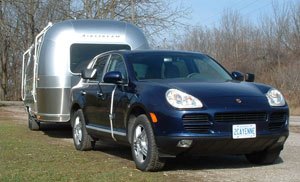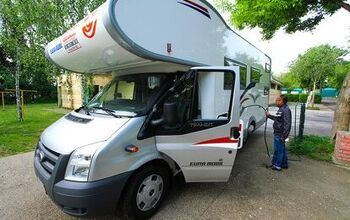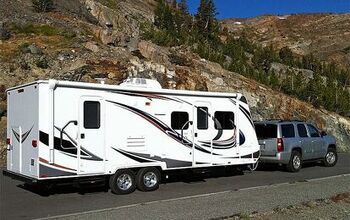2005 Airstream Safari Review
The Airstream trailer is the most recognizable RV on the road today. Few people (if any) will argue that fact. I make this obvious statement because unlike many newer brands the Airstreams “look” is a large part of its appeal. It’s this look and the Airstream’s long history that has made the marketing of this classic trailer design successful, despite the fact that Airstream does not offer the current trends of multiple slideouts, cavernous basement storage and fifth wheel models. So from that point of view, it becomes very important for the company and the buyer alike to feel that this product is unique. At least that’s what I was thinking as I sat in my 28-foot Safari test trailer this past fall.
This needs to be said right up front. If it’s limitless interior space you desire – the Airstream doesn’t have it. If you want storage doors that a standard wooden pallet could fit through – the Airstream doesn’t have it. What the Airstream does have is a revered place in RV history. What it gives its owners (besides a decent product) is a sense of belonging to that history. I think I can best describe the Airstream appeal by borrowing a bumper sticker catch phrase from the Jeep people; “It’s an Airstream thing – you wouldn’t understand.”
The Airstream trailer company has been around in one form or another since 1931 with the greatest number of its bright aluminum skinned trailers being built post-WWII. Airstream’s popularity echoed the growth in auto sales, rising income and interest in travel that followed the war and the company boomed. Airstream trailers became part of the landscape and part of American culture. Want proof? There are Airstream trailers in the Smithsonian institution and the Henry Ford museum. Remember Life magazine covering the Gemini astronaut’s splashdown? NASA used Airstreams to house those returning astronauts and still uses them today.
The funny thing about this test is that it came about because the marketing representative for Porsche kept haranguing me to tow something with his new Porsche Cayenne SUV. “It’ll tow almost 9,000 lb” he said. Fine, but who is going to tow with a $90,000 Porsche? Finally, I offered the only thing I could think of that would at least look cool being towed by a Porsche – the Airstream. He jumped at the idea.
The trailer that was suggested for the test was the 28-foot Safari. This trailer can be towed by many of today’s SUVs and mini-vans. Four different models of Safari can sleep up to six people with the newest model sleeping eight. Our tester was the six sleeper – 28W, nicely equipped with a few optional extras – like the flat screen TV.
These 2004 Safari’s feature laminated surfaces throughout the interior. These are clean and light. Overhead compartment doors are rounded and feature brushed nickel hardware, not a bit of brass in sight. Fabrics tend towards the warm, comfort tones. All Safari trailers can be upgraded with an LS package that includes distinctive décor, Ultra Leather sofas, LED taillights, black tank flush, a Moen filter faucet and other luxury items.
The kitchen area gets hard-wearing and easy to clean vinyl flooring, a three-burner range with oven and an optional microwave. You’ll find stainless steel sinks with covers and lots of storage and cupboard space. The six-cubic foot refrigerator has two doors and automatically switches between propane and shore power. This model also had a bright aluminum panel insert.
Vinyl flooring is also found in the bathroom and in this model the shower is separate. Rather than using a second outside door, the shower door itself (a full-size glass door) is the entry point. The shower is full height with the fiberglass insert enclosing the entire space; there is a steam vent in the roof.
For entertainment there is a standard AM/FM/CD receiver with four spaced and mounted speakers. The radio and TV antenna is already installed. There are two cable outlets, as well as phone jacks and the wiring for a satellite feed is already in place. What is optional is a 12V LCD flat screen TV with 15-inch screen. If you are off the beaten path, two deep-cycle house batteries will keep your systems alive. Incidentally prewiring for solar panels is in place as a standard feature.
My tester had the tropical oak interior. This is a light colored laminate that keeps the mood of the trailer airy and open. Not to mention how well this wood looks on the gently curved storage cupboard doors that accentuate the shape of the trailer. I noted that rather than blinds there are full black-out drapes throughout the unit.
The Safari comes with a standard set of styled aluminum wheels, though the ones in my photographs are actually a custom set installed by CanAm. The thought being that they were more fitting for a test with a Porsche. The twin axles sport 15-inch all-season radial tires and 12-inch electric brake rotors. Once you are parked there are four standard stabilizer jacks to keep things from rocking.
The Airstream’s underbelly is fully enclosed and its low profile dropped frame is what adds to its aerodynamic proportions. According to Airstream’s claims, its trailer can net you up to 20 percent fuel savings over towing a similarly sized square trailer. The enclosed underside is also insulated and the holding tanks are warmed by the forced air furnace making this unit four-season usable. It also comes with a patio side retractable awning standard.
Storage on the Airstream is also pretty much classic. An outside, rear hinged door offers access to three storage bins under the bed. While under the forward lounge there is space for two storage boxes. This is pretty minimal and while classic – is another of the compromises the buyer has to make when wanting to own an icon. That really is the only drawback to the Airstream that I can see. The original aerodynamic shape that also offered the most interior space has now been eclipsed by full-frame basement chassis and multiple slideouts that are standard fare for most other brands.
The Porsche Cayenne I used in the test may be an SUV, but it’s built like a sports car; nevertheless it will tow up to 8,900 pounds. The handling is responsive, agile and precise. The 4.5L V8 engine delivers plenty of power with steady acceleration. The permanent all-wheel drive system is combined with a two-speed transfer case and lockable center differential to deliver reliable traction and control on every surface. Driver aids such as Porsche Traction Management (PTM) and Porsche Stability Management (PSM) are seamlessly integrated to ensure the Cayenne always maintains its composure.
The hitch weight of the Safari is 890 lb. So, we attached it to the factory installed hitch receiver with a 2-5/8” ball and a set of equalizer bars. These were adjusted till we got a flat profile. (We accomplished this by measuring the front bumper to the ground distance – first with the weight off and then on – we keep adjusting till the difference was zero) We then set off to try a number of towing maneuvers. Acceleration and braking were good. Stability during lane changes was very good. Overall drivability at speed was excellent. In fact it was so good that (in a controlled environment) we gradually increased our top tow speed over several runs to 100mph. Even at this speed the combination was rock steady.
























